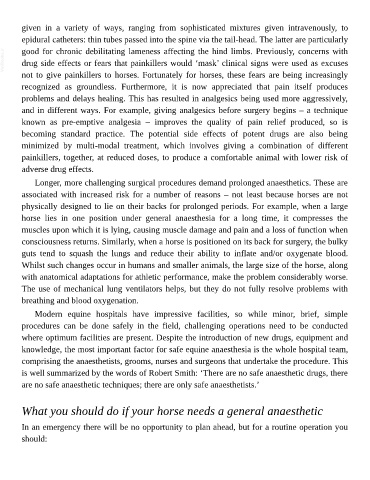Page 1089 - The Veterinary Care of the Horse
P. 1089
given in a variety of ways, ranging from sophisticated mixtures given intravenously, to
epidural catheters: thin tubes passed into the spine via the tail-head. The latter are particularly
VetBooks.ir good for chronic debilitating lameness affecting the hind limbs. Previously, concerns with
drug side effects or fears that painkillers would ‘mask’ clinical signs were used as excuses
not to give painkillers to horses. Fortunately for horses, these fears are being increasingly
recognized as groundless. Furthermore, it is now appreciated that pain itself produces
problems and delays healing. This has resulted in analgesics being used more aggressively,
and in different ways. For example, giving analgesics before surgery begins – a technique
known as pre-emptive analgesia – improves the quality of pain relief produced, so is
becoming standard practice. The potential side effects of potent drugs are also being
minimized by multi-modal treatment, which involves giving a combination of different
painkillers, together, at reduced doses, to produce a comfortable animal with lower risk of
adverse drug effects.
Longer, more challenging surgical procedures demand prolonged anaesthetics. These are
associated with increased risk for a number of reasons – not least because horses are not
physically designed to lie on their backs for prolonged periods. For example, when a large
horse lies in one position under general anaesthesia for a long time, it compresses the
muscles upon which it is lying, causing muscle damage and pain and a loss of function when
consciousness returns. Similarly, when a horse is positioned on its back for surgery, the bulky
guts tend to squash the lungs and reduce their ability to inflate and/or oxygenate blood.
Whilst such changes occur in humans and smaller animals, the large size of the horse, along
with anatomical adaptations for athletic performance, make the problem considerably worse.
The use of mechanical lung ventilators helps, but they do not fully resolve problems with
breathing and blood oxygenation.
Modern equine hospitals have impressive facilities, so while minor, brief, simple
procedures can be done safely in the field, challenging operations need to be conducted
where optimum facilities are present. Despite the introduction of new drugs, equipment and
knowledge, the most important factor for safe equine anaesthesia is the whole hospital team,
comprising the anaesthetists, grooms, nurses and surgeons that undertake the procedure. This
is well summarized by the words of Robert Smith: ‘There are no safe anaesthetic drugs, there
are no safe anaesthetic techniques; there are only safe anaesthetists.’
What you should do if your horse needs a general anaesthetic
In an emergency there will be no opportunity to plan ahead, but for a routine operation you
should:

